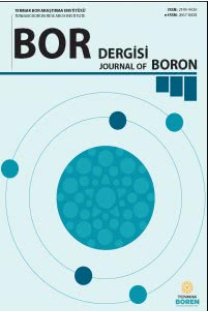Effects of polyelectrolytes on the hardness of borax decahydrate crystals
Borax decahydrate, crystal hardness polyelectrolyte, PRS model,
___
- [1] McMillian P. W., Glass-Ceramics, 2nd edition, Academic Press, New York, 1979.
- [2] Ceyhan A. A., Sahin Ö., Bulutcu, A. N., Crystallization kinetics of the borax decahydrate, J. Cryst. Growth, 300 (2), 440–447, 2007.
- [3] Gurbuz H., Ozdemir B., Experimental determination of the metastable zone width of borax decahydrate by ultrasonic velocity measurement, J. Cryst. Growth, 252 (1-3), 343–349, 2003.
- [4] Mannepalli S., Mangalampalli K. S. R. N., Indentation plasticity and fracture studies of organic crystals, Crystals, 7, 324, 2017.
- [5] Dieter G. E., Mechanical Metallurgy, Mc Graw Hill, New York, 1961.
- [6] Suresh S., Techniques and tools used for investigating the grown crystals: Review, Latin-American Phys. Educ., 6 (4), 547-558, 2012.
- [7] Tian Y., Xu B., Zhao Z., Microscopic theory of hardness and design of novel superhard crystals, Int. J. Refract. Met. Hard Mater., 33, 93-106, 2012.
- [8] Verma A. K., Ojha C., Shrivastava A. K., Effects of impurities on the hardness of alkali halide single crystals, AIP Conf. Proc., 1591, 1242, 2014.
- [9] Tavakoli M. H., Abasi T. A., Ali E. H., Growth of KCl crystal by Czochralski method and influence of nanodiamond impurity on its hardness and optical properties, Cryst. Res. Technol., 48 (3), 130-137, 2013.
- [10] Kishi T., Suzuki R., Shigemoto C., Murata H., Kojima K., Tachibana M., Microindentation hardness of proteins crystals under controlled relative humidity, Crystals, 7 (11), 339, 2017.
- [11] Amala B. M., Bindhu M. R., Studies on the effect of sodium chloride on ammonium dihydrogen phosphate single crystals, IJERT, 4 (9), 315-318, 2017.
- [12] Ding S., Zhang Q., Liu W., Luo J., Sun G., Sun D., Crystal growth, defects, mechanical, thermal and optical properties of Tb3Sc2Al3O12 magneto-optical crystal, J. Cryst. Growth, 483,110-114, 2018.
- [13] Meyer E., Contribution to the knowledge of hardness and hardness testing, Z. ver, Dtsch. Ing. 52, 645–654, 1908.
- [14] Onitsch E. M., Micro-hardness testing, Mikroscopia. 2, 131–151, 1947.
- [15] Hanneman M., Metall. Manchu. 23, 135, 1941.
- [16] Goel N., Sinha N., Kumar B., Growth and properties of sodium tetraborate decahydrate single crystals, Mater. Res. Bull. 48 (4), 1632–1636, 2013.
- [17] Guo J., Chen, X., Zhang Y., Improving the mechanical and electrical properties of ceramizable silicone rubber/halloysite composites and their ceramic residues by incorporation of different borates, Polymers, 10 (4), 388, 2018.
- ISSN: 2149-9020
- Yayın Aralığı: 4
- Başlangıç: 2016
- Yayıncı: TENMAK Bor Araştırma Enstitüsü
Effect of Fe doping on photocatalytic activity of B2 O3processed using polyvinyl borate precursor
Effects of polyelectrolytes on the hardness of borax decahydrate crystals
Üstün özelliklere sahip ileri teknoloji seramiği: Titanyum diborür
Fatih AKKURT, Emine KALENDER, Abdulkerim YÖRÜKOĞLU
Aysel UGUR, Ozgur CEYLAN, Rukiye BORAN, Semih AYRİKCİL, Nurdan SARAC, Dervis YİLMAZ
Özgür Ceylan, Rukiye Boran, Aysel Uğur, Semih Ayrıkçil, Nurdan Saraç, Derviş Yılmaz
Crystal structure, 1 H and 13C NMR spectral studies of 1,2,4,5-oxadiazaborole derivatives
